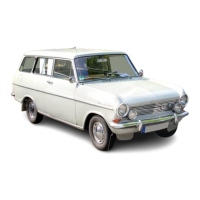9 Push the piston into its bore and repeat the
operation on the opposite piston.
Refitting
10 Prior to refitting, remove all traces of
locking compound from the caliper mounting
bolt threads and the hub carrier holes. Apply a
drop of fresh locking compound to the bolt
threads. Refit the caliper and insert the
mounting bolts, tightening them to the
specified torque setting (see illustration).
11 Reconnect the brake pipe to the caliper
and tighten its union nut to the specified
torque setting.
12 Refit the brake pads as described in
Section 5.
13 Remove the brake hose clamp or
polythene, where fitted, and bleed the
hydraulic system as described in Section 2.
Note that providing the precautions described
were taken to minimise brake fluid loss, it
should only be necessary to bleed the
relevant rear brake.
14 Refit the roadwheel, aligning the marks
made on removal, then lower the vehicle to
the ground and tighten the roadwheel bolts to
the specified torque.
Note: Before starting work, refer to the note at
the beginning of Section 2 concerning the
dangers of hydraulic fluid and to the warning
at the beginning of Section 6 concerning the
dangers of asbestos dust.
Removal
1 Remove the brake drum (Section 9).
2 Using pliers, carefully unhook the upper
brake shoe return spring and remove it from
both brake shoes. Pull the upper ends of the
shoes away from the wheel cylinder to
disengage them from the pistons.
3 Minimise fluid loss by either removing the
master cylinder reservoir cap and then
tightening it down onto a piece of polythene
to obtain an airtight seal, or by using a brake
hose clamp, a G-clamp or a similar tool to
clamp the flexible hose at the nearest
convenient point to the wheel cylinder.
4 Wipe away all traces of dirt around the
brake pipe union at the rear of the wheel
cylinder and unscrew the union nut. Carefully
ease the pipe out of the wheel cylinder and
plug or tape over its end to prevent dirt entry.
Wipe off any spilt fluid immediately.
5 Unscrew the two wheel cylinder retaining
bolts from the rear of the backplate and
remove the cylinder taking great care not to
allow surplus hydraulic fluid to contaminate
the brake shoe linings.
Overhaul
6 Brush the dirt and dust from the wheel
cylinder, taking care not to inhale it, and pull
off the rubber dust excluders from the cylinder
body (see illustration).
7 The pistons will normally be ejected by
pressure of the coil spring but if they are not,
tap the end of the cylinder on a piece of
hardwood or apply low air pressure from a
tyre foot pump at the pipeline connection.
8 Inspect the surfaces of the piston and the
cylinder bore for rust, scoring or metal-to-
metal rubbed areas. If these are evident,
renew the wheel cylinder complete.
9 If these components are in good order,
discard the seals and dust excluders and
obtain a repair kit which will contain all the
renewable items.
10 Fit the piston seals (using the fingers only
to manipulate them into position) so that the
spring is between them. Dip the pistons in
clean hydraulic fluid and insert them into the
cylinder.
11 Fit the dust excluders.
Refitting
12 Ensure that the backplate and wheel
cylinder mating surfaces are clean then
spread the brake shoes and manoeuvre the
wheel cylinder into position.
13 Engage the brake pipe and screw in the
union nut two or three turns to ensure that the
thread has started.
14 Insert the two wheel cylinder retaining
bolts and tighten them to the specified torque
setting. Now tighten the brake pipe union nut
to the specified torque.
15 Remove the clamp from the flexible brake
hose or the polythene from the master
cylinder reservoir (as applicable).
16 Ensure that the brake shoes are correctly
located in the cylinder pistons then carefully
refit the brake shoe upper return spring, using
a screwdriver to stretch the spring into
position.
17 Refit the brake drum as described in
Section 9.
18 Bleed the brake hydraulic system as
described in Section 2. Providing suitable
precautions were taken to minimise loss of
fluid, it should only be necessary to bleed the
relevant rear brake.
Note: Before starting work, refer to the
warning at the beginning of Section 2
concerning the dangers of hydraulic fluid.
Removal
1 Remove the master cylinder reservoir cap
and syphon the hydraulic fluid from the
reservoir. Note: Do not syphon the fluid by
mouth, as it is poisonous; use a syringe or an
old poultry baster. Alternatively, open any
convenient bleed screw in the system and
gently pump the brake pedal to expel the fluid
through a plastic tube connected to the screw
(see Section 2).
2 Release the cable retainer from around the
master cylinder body (where applicable).
3 Wipe clean the area around the brake pipe
unions on the side of the master cylinder and
place absorbent rags beneath the pipe unions
to catch any surplus fluid. Make a note of the
correct fitted positions of the unions then
13 Master cylinder - removal and
refitting
12 Rear wheel cylinder -
removal, overhaul and refitting
Braking system 9•11
9
11.10 Tighten the rear caliper mounting
bolts to the specified torque setting
12.6 Exploded view of a rear wheel cylinder
1 Dust cap
2 Bleed screw
3 Cylinder body
4 Dust excluder
5 Piston
6 Seal
7 Spring

